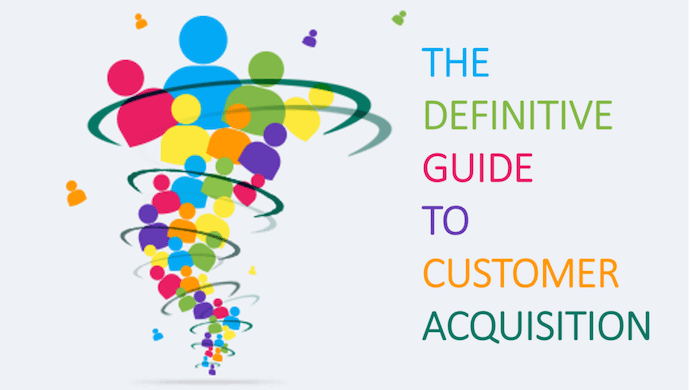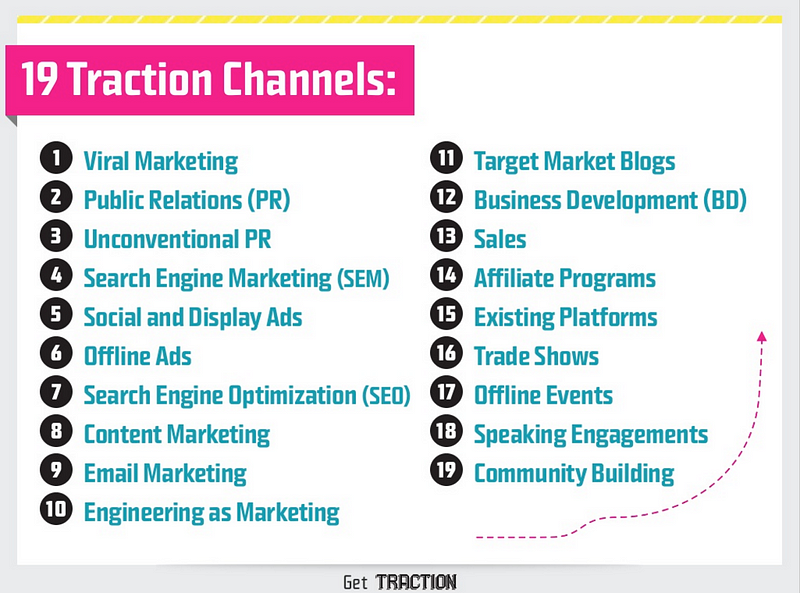The right way to go from zero to hero

This post specifically pertains to early stage startups as they navigate from 0 to 1,000 users and go about discovering a scalable growth channel.
Customer acquisition: an afterthought?
In my interactions with several entrepreneurs and founders, their go-to marketing strategy is “social media” or “content marketing”. This is without regard for what the product is, because customer acquisition seems to be an afterthought. Some throw out random words include Facebook, Google, SEO.
It’s worrying that many entrepreneurs building great products don’t know the basics of customer acquisition. As I read through the available material online, it’s remarkable that a simple step-by-step guide for early stage customer acquisition doesn’t exist.
We end up with comprehensive acquisition strategies that mention every possible channel the founder can think of. But this doesn’t work.
With limited runway and time to gain traction, simply throwing everything at the wall and hoping something sticks simply won’t work.
Here are all the acquisition channels available to you
Here‘s everything you need to read to get it done. It’s a great list, but holy cow! A list of blogs which link to other blogs which link to other blogs? You can’t read everything on that list! Even if you tried, you’d be paralysed with too much disjointed information that don’t piece together.
In the end, you won’t really know what to do and go back to throwing everything but the kitchen sink at the wall. But there is a better way.
A 3-step guide to customer acquisition
Every single business is different. That’s why it isn’t quite as straightforward as telling you what the best channel is. But it is as straightforward as following a process.
There is a simple process to figure out which channels are right for YOUR business.
Step 1: Intent vs Interest
The first question to ask yourself is :
Is my product an intent-based product or an interest-based product?”
It’s a pretty simple question to answer. Put into simpler terms, are users already looking for your product i.e., demonstrating intent to purchase?
If they are, they’re looking for it on Google. Imagine what search queries your users could be using, type them into the Google Keyword Planner and check out the suggestions and volumes that come back. If there’s significant enough volumes, Search Engine Marketing (SEM) is the channel you should focus on.
Say your product is a platform for people to discover divorce lawyers online , an intent-based product if ever there was one. SEM is your channel — thousands of potential customers are searching for your solution. You simply need to capitalise on the existing demand and win at SEM.
Think about it. How many people are going to subscribe to a blog about getting a divorce? Or how many customers do you think you’re going to get by advertising on Instagram? Those channels simply will not work.
An intent-based product is something that your users don’t care about at all — until they need it. Other examples of intent based products are flights, hotels, storage, cleaning services, home services, property agent services, loans, funeral services, and mortgages to name a few.
Once you validate that those users on search are the right customers for your business (i.e., they are converting at scale), you can then focus on the other pillar of search — Search Engine Optimisation (SEO) — and follow Brian Dean‘s methodology to rank on page 1 of Google.
Alternatively, your product could be an interest-based product. SEM will definitely not work for you – there’s no one looking for what you offer on Google. Unfortunately for you, things might be slightly less simple for you than those damned divorce lawyers.
Step 2: Who are your customers?
If your response to this is :
Everyone is a potential customer …
You’re wrong. You may have a great product — but if you don’t segment your market, you won’t be able to speak any of the different segments effectively.
Start by coming up with at least one ideal customer persona. There are two simple questions to ask yourself that would help you formulate the ideal customer:
- Who would this product/service deliver value to?
- Where do they hang out online?
Let’s say you launched an app in Singapore that connects parents of toddlers with other parents so the kids can make new friends.
Let’s go through the questions.
1. Who does the app deliver value to?
- Parents of toddlers aged 3 – 8.
2. Where do they hang out online?
- They likely spend time on social media
- They read parenting sites like TheAsianParent & SingaporeMotherhood
Using this information, we can now craft a first draft ideal customer profile based on this.
- Demographic (Gender): Male & Female
- Demographic (Age): 28 – 40 years old
- Demographic (Parents): Are parents of 3 – 8 year olds
- Spends time on: Facebook, Instagram(?), Parenting sites
Step 3: Reach them where they are
Using the information above, you already know where to reach them — Facebook.
Throw in the information above into the Facebook ad editor and it’ll let you reach your ideal customers in a couple of clicks.

35,000 young parents living in Singapore that Facebook know about. There’s your audience, and this is a potential acquisition channel.
But we found another channel when coming up with our ideal customer. Remember those parenting sites before? They sell display ads on their site. That means you can reach their readers whilst they’re reading this parenting stuff.
Let’s take a look at TheAsianParent. Three display ads easily accessible through Google’s Display Network on their homepage – getting you access to >300,000 Asian parents for an average of S$1.25 (around US$0.88) per click. Seems like a pretty great, deal doesn’t it?

TheAsianParent homepage with 3 ads served through GDN.

TheAsianParent stats. That’s a lot of Asian parents to get your app in front of, fast.
That’s only 1 site. Add the other parenting sites on the Google Display Network and you can easily reach hundreds of thousands of users using those sites every week.
Why all paid?
So I know I’ve been recommending paid channels only in this post. Are there free channels you can consider — totally. Those simply take a little time for you to figure out if they work. As I said in the beginning, time is of the essence and paid marketing gets you traffic onto your site today and helps you figure out what works so you can figure out next steps.
It’s not the end-all. It’s simply the first channel that helps you to learn more about your customers. It leads to developing other channels in the future.
- If leads from SEM are converting, you need to invest in SEO at some point.
- If leads from GDN are converting, a content marketing strategy is likely to have a place in your marketing mix so you own the content they read.
- If leads from Facebook ads are converting, try out a referral programme that gets your users to share your product on social media.
Tips & tricks
Pick one channel
As I was writing this article, I came across Neil Patel’s take on marketing channels for brand new businesses.
One thing that I definitely agree with him on is to pick one channel and invest your time and effort in it.
It’s easy to set up an Adwords campaign or Facebook campaign, watch it crash and burn $1,000 and declare that it’s a hack, call me a few names and declare it’s the wrong channel for you.
I did the same thing at my first marketing job. Tried a couple of channels — nothing worked. But that’s because I was (a) using the wrong channels, and (b) doing a bad job on the right channels.
If you’ve gone through the above steps 1-3, you know your customers are on the other side. You can be sure of it. So you won’t be in danger of using the wrong channels.
So we know you’ll be using the right channel. If you’re not seeing conversions, break it down and figure out why things may not be working.
- Do you have a low click-through rate?
- Why aren’t people clicking on your ad?
- Is your ad relevant?
- Is it attractive? Does it make people want to click?
- Does it show up for the right search terms?
- Go really, really deep into that channel. It won’t be a waste of time. I can guarantee you’ll learn something about your customers.
The only way you should abandon a channel is if you’ve got a definitive understanding of why it isn’t working.
For example:
SEM is not the right channel for us because we’re offering a premium intent-based product. After studying search term reports, we’ve identified that users searching on Google are looking for “discount” or “cheap” products. As our strategy is to price high, the users searching on Google are not our target audience.
Make sure you’ve got fundamentals in place
Everything I’ve mentioned above won’t work without some basics in place.
- You need analytics set up on your site. Without it, you can’t track anything including conversions and there’s simply no way for you to know whether something is working or not.
- Don’t send users to your home page. This should seem pretty self-explanatory, but it happens surprisingly often. When users click on an ad, they want to go to a relevant page, not navigate around your site to find whatever the ad was talking about. Don’t make it harder for them to convert.
- Understand the channels before you start. Google and Facebook have complex workings. Yes, they’ve made it incredibly easy for you create an account and start running ads but you will lose money if you don’t understand how they work. Whilst it’s strongly recommended you work with someone who has some level of experience on these platforms, you can choose to go it alone. If you do, read up on Adwords or Facebook before you get started.
—-
Read more of my stuff and subscribe to my newsletter at startupmarketing.today.
The views expressed here are of the author’s, and e27 may not necessarily subscribe to them. e27 invites members from Asia’s tech industry and startup community to share their honest opinions and expert knowledge with our readers. If you are interested in sharing your point of view, submit your post here.
The post The definitive 3-step guide to early-stage customer acquisition appeared first on e27.

